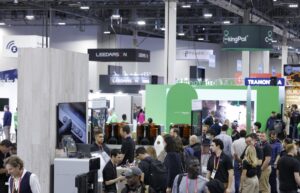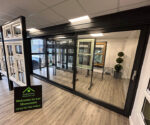Innovations in smart home glass, windows, and security systems dominate 2024 CES
 Las Vegas, 2024 – The Consumer Electronics Show (CES) has always been the launchpad for groundbreaking technology, but this year, the spotlight was firmly on the latest innovations in smart home technology, particularly in the realms of glass, windows, doors, and locking systems.
Las Vegas, 2024 – The Consumer Electronics Show (CES) has always been the launchpad for groundbreaking technology, but this year, the spotlight was firmly on the latest innovations in smart home technology, particularly in the realms of glass, windows, doors, and locking systems.
At the forefront of these advancements is ClearView Tech, unveiling its revolutionary ‘SmartGlass’ – a dynamic glass technology that changes transparency and tint based on external conditions and user preferences. SmartGlass, capable of transforming from transparent to opaque in seconds, promises not only enhanced privacy but also significant energy savings by regulating natural light and heat.
Another showstopper was the ‘SolarWindow’ by EcoTech Innovations. These ingenious windows double as solar panels, harvesting sunlight to generate electricity. The sleek design and efficient energy conversion challenge the traditional notions of renewable energy integration in home design. SolarWindow demonstrates a leap towards self-sustaining homes, contributing significantly to reducing carbon footprints.
A further highlight was from Zeiss who says that large windows in smart homes could not only host 3D “holographic” imagery, but could also channel concentrated sunlight to hidden solar cells to produce energy. Applications of ZEISS Multifunctional Smart Glass technology can be found especially in the smart home. For example, innovative interior lighting can be realized through special holographic decoupling elements in exterior glass that is almost indistinguishable from natural light. Window panes can be illuminated evenly over wide areas – with adjustable lighting moods to complement existing smart home solutions.
Glass surfaces can also generate energy. The microoptical layer in the window pane absorbs incident sunlight and transmits it in concentrated form to a solar cell. This combines the advantages of conventional windows – natural light and an unrestricted view – with the additional benefit of efficient energy production. As a result, the innovative ZEISS technology will make surfaces available for power generation in the future that could not previously serve that purpose: office building facades and windows of high-rise apartment buildings and other residential housing. This creates new opportunities to capture energy anywhere that glass panels are used.
The realm of doors and entry systems saw equally impressive innovations. SecureEntry showcased their ‘BioSecure’ door system, featuring advanced biometric technology. BioSecure doors use facial recognition and fingerprint scanning to offer a high level of security, eliminating the need for traditional keys or access codes. The system also integrates seamlessly with home automation systems, allowing for remote monitoring and control.
Locking systems have not been left behind. IntelliLock’s ‘LinkLock’ system was a crowd-puller, offering a new level of convenience and security. LinkLock, a smart locking system, allows homeowners to control and monitor access to their homes via a smartphone app. What sets it apart is its ability to link with other home devices, enabling scenarios like automatic unlocking when a recognized vehicle approaches the driveway.
A significant trend at this year’s CES was the integration of AI and machine learning in these technologies. For instance, AI-driven analytics in smart windows and doors can now predict user preferences and adjust settings for optimal comfort and energy efficiency. This AI integration not only enhances user experience but also pushes the boundaries of what smart homes can achieve in terms of energy conservation and security.
The focus on environmental sustainability was evident. Many of the showcased products, like the SolarWindow, not only offer smart features but also contribute to reducing the environmental impact of homes. These innovations reflect a growing consumer demand for eco-friendly and energy-efficient home solutions.
Another noteworthy aspect of this year’s exhibition was the emphasis on user-friendly interfaces and seamless integration with existing home ecosystems. Companies are moving towards systems that can be easily controlled via smartphones or voice commands, ensuring that the benefits of these advanced technologies are accessible to everyone.
Safety and privacy concerns associated with these technologies were also addressed. Manufacturers showcased their commitment to data security, with many products featuring advanced encryption and privacy protection measures. This focus on security is crucial in gaining consumer trust and facilitating the adoption of smart home technologies.
In summary, the 2024 CES exhibition has painted a picture of a future where our homes are not just dwellings, but intelligent environments that respond to our needs, protect our privacy, and contribute to a sustainable future. The advancements in smart glass, windows, doors, and locking systems displayed at the event mark a significant step forward in the evolution of smart home technology. As these innovations make their way from the exhibition floor into our homes, they hold the promise of transforming our living spaces in ways we are only beginning to imagine.











